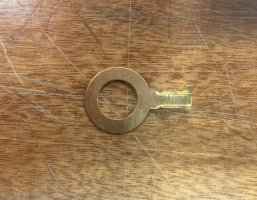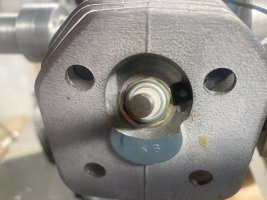You are using an out of date browser. It may not display this or other websites correctly.
You should upgrade or use an alternative browser.
You should upgrade or use an alternative browser.
Scale Wendell Hostetler 30% PA-28 Cherokee Build
- Thread starter TonyHallo
- Start date
pawnshopmike
Staff member
Well I plan to build back better!!!

TonyHallo
640cc Uber Pimp
Yes, very stupid mistake on my part. I used a stabilized receiver that I had the the three way switch programed backwards. Never gave any indication that the stabilization was turned on until the plane broke ground. I had planned to fly the flight with it off until the plane was trimmed and adjusted. Since I wasn't planning to use it I never calibrated it to the final installation. The receiver was turned on to self level mode when I took off and the rest is history.
There were a few things that I didn't like about the build so I get a chance to correct those on the next try. Finishing up a few planes in the hanger that needed finished before starting the next build. Should go a little quicker since I have the molds and plugs made already.
There were a few things that I didn't like about the build so I get a chance to correct those on the next try. Finishing up a few planes in the hanger that needed finished before starting the next build. Should go a little quicker since I have the molds and plugs made already.
As Burt Rutan would say, “the technology you leave out cannot fail you.” 
And as we use to say, PFU...
While I think computer radios have merit, I also wonder how many potential mistakes lie in all those settings? Especially for those not as computer savvy as most. I'd be curious of all the features in one typical computer radio, what percentage of those features are used by a typical modeler?
I still fly a Futaba Gold box some 40 years young. And to be honest I have yet to see any feature a computer radio has that I simply just can't live without. But I would like to see changes in cylinder head temp telemetry. Better probes that either fit under the plug (glow or spark) or become part of a head bolt. And the ability to monitor as many as nine cylinder heads for a real reading of these new, very expensive multies we now have. Just because cylinder #1 reads fine doesn't mean one of the others isn't too lean or rich.
And as we use to say, PFU...
While I think computer radios have merit, I also wonder how many potential mistakes lie in all those settings? Especially for those not as computer savvy as most. I'd be curious of all the features in one typical computer radio, what percentage of those features are used by a typical modeler?
I still fly a Futaba Gold box some 40 years young. And to be honest I have yet to see any feature a computer radio has that I simply just can't live without. But I would like to see changes in cylinder head temp telemetry. Better probes that either fit under the plug (glow or spark) or become part of a head bolt. And the ability to monitor as many as nine cylinder heads for a real reading of these new, very expensive multies we now have. Just because cylinder #1 reads fine doesn't mean one of the others isn't too lean or rich.
-Rick-
100cc
PFU?
I somewhat agree with you but....
I could not live without servo reversing, expo and many other things in these "computer radios". Both my crashes were because I did dumb things! First one because I was giving a demonstration to a group of developmentally challenged people, I was doing a range check and on the way back to the plane I had one finger the the aileron trim and moved it completely left without knowing this. I caught it before I took off but in my haste I did not correct the simple problem. I re calibrated the sticks forgetting about the switches. More to the story but that led to the crash. Second crash was because again I was in a hurry and did not do something I ALWAYS do, a control surface check. I was just trying to add a flap to elevator mix and went about it very wrong! I had no up elevator.
As far as head temps I have copper rings that fit between the plugs and the top of the cylinder. Works great but do not know if there is anything out there for seven cylinders, I use it on all my twins.
I use many mixes on my planes, do I really need them? No, but I really like to have them!!
I flew my first plane back in the day when my first radio did not even have servo reversing. I, for one am very glad the radios have come as far as they have.
I somewhat agree with you but....
I could not live without servo reversing, expo and many other things in these "computer radios". Both my crashes were because I did dumb things! First one because I was giving a demonstration to a group of developmentally challenged people, I was doing a range check and on the way back to the plane I had one finger the the aileron trim and moved it completely left without knowing this. I caught it before I took off but in my haste I did not correct the simple problem. I re calibrated the sticks forgetting about the switches. More to the story but that led to the crash. Second crash was because again I was in a hurry and did not do something I ALWAYS do, a control surface check. I was just trying to add a flap to elevator mix and went about it very wrong! I had no up elevator.
As far as head temps I have copper rings that fit between the plugs and the top of the cylinder. Works great but do not know if there is anything out there for seven cylinders, I use it on all my twins.
I use many mixes on my planes, do I really need them? No, but I really like to have them!!
I flew my first plane back in the day when my first radio did not even have servo reversing. I, for one am very glad the radios have come as far as they have.
TonyHallo
640cc Uber Pimp
What changes? It's all there now. The lug below accepts a CM6 plug, the thermistor bulb are crimped in the lug and a little heat shrink tube and you have plug indication. For 1/4"-32 plugs I use a 10-12 gage 1/4" lug. How many temps do you need? You can daisy chain FrSky SP-RPM RPM/Temp sensor to get as many as you need, two temperature sensors per device, you must change the channel so that each device is unique. I have both plugs monitored and will measure incoming and air leaving on the plane I am currently finishing up. The sensors were in the Cherokee
Attachments
PFU? First word is Pilot, last is Up. Don't think the forum mods will let me tell you the middle word.PFU?
I somewhat agree with you but....
I could not live without servo reversing, expo and many other things in these "computer radios". Both my crashes were because I did dumb things! First one because I was giving a demonstration to a group of developmentally challenged people, I was doing a range check and on the way back to the plane I had one finger the the aileron trim and moved it completely left without knowing this. I caught it before I took off but in my haste I did not correct the simple problem. I re calibrated the sticks forgetting about the switches. More to the story but that led to the crash. Second crash was because again I was in a hurry and did not do something I ALWAYS do, a control surface check. I was just trying to add a flap to elevator mix and went about it very wrong! I had no up elevator.
As far as head temps I have copper rings that fit between the plugs and the top of the cylinder. Works great but do not know if there is anything out there for seven cylinders, I use it on all my twins.
I use many mixes on my planes, do I really need them? No, but I really like to have them!!
I flew my first plane back in the day when my first radio did not even have servo reversing. I, for one am very glad the radios have come as far as they have.
My Futaba Gold box from the 80's has servo reversing, expo and even a mix which I've never used. Come to think of it so did my 70's series Kraft radio. And I can reverse a servo faster than a computer radio can. Pop a plastic cover and throw a switch. Maybe 10 seconds. Many of the "other things" we worked around in the old days (1970's-80's). And I agree there are some things only computers can do but how necessary or widely used might that feature be is another matter.
I'm retired IT (23 years) and know full well how easy computers make some things. To include mistakes. I made a lot of money chasing those mistakes made by others. And I'm convinced that for the majority of the flying out there, that much radio capability simply isn't needed. How many potential new bees have been chased away by the price of those radios and engines too?
But think of it this way. How fast do people type when texting? How much of that typing is back tracking to enter the correct letter? Same kind of thing happens on the radios. As one gets use to the system and their entries speed up. They get faster on the keyboard so to speak. And that increases the chance of a typo. Maybe what we need is a written checklist for every model?
As for CHT, I do know Graupner can be configured to do 4 cylinders. Which is my target set up. But it is something of a kludge. Not exactly planned in the design of the radio but can be made to work. Last I checked anyway. And it's been a couple of years since I last checked so who knows what's available now.
I'd be curious to know who makes your ring style temp sensors? I fabricated my own just like Tony mentioned above and they work just fine. Something the radio manufacturers won't tell you is how simple those probes really are. They want you to think you have to use OEM parts in order to get that special magic only they have. Bottom line is the probe is most likely either a K or J type. That dictates the wire type which should be maintained all the way through the circuit. But I'll wager every radio stops the different wires at the plug.
However, for the direction a lot of models are going now, bigger, faster, more complicated, etc. I'll agree computer radios can be a real plus. But again the 'P' needs to be on top of things in order to avoid an increase in PFU's.


